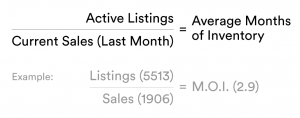Here’s one way to do this.
Learning to convert local market statistics (available to everyone) into real estate market intelligence.
.
The average Months of Inventory (MOI) tells us roughly how many months (or days of inventory in some cases) it would take to sell ALL of the active inventory in that market. It is a key market indicator that determines whether or not you are in a buyer’s market, a seller’s market or a balanced market.
Quickly, here’s how to make the MOI calculation:.
.

.
Adding the Insight
Anyone can get this data online by looking at their local board numbers but here’s how to add insight. Understanding what type of market you are working is key to helping your clients make better real estate decisions. An average MOI between 5 and 6 months is considered a balanced market. Below 5 months is a seller’s market and above 6 is a buyer’s market.
Increase the Impact by Adding Relevance
The secret to making this work even better is breaking it down further. Go beyond calculating this for your city and instead calculate the numbers that are most relevant to your buyers and sellers. Target a specific geographic area, concentrate on properties you specialize in, such as detached, waterfront, condos etc.
Now that’s what I call “real estate market intelligence.” Once you can offer insightful, real estate market intelligence, will commission become less of an issue? Most likely, as your clients can clearly see value in you and your ability to interpret the plethora of information and deliver insight they did not have.
So have a little fun with this, play around with some of the numbers, get to know them and understand the information until it becomes second nature to you.
Until next time, make it count!
Richard
PS Want to learn a dozen more ideas to communicate your value? Join us here – Masters Academy Real Estate Conference this July 5 & 6, 2017